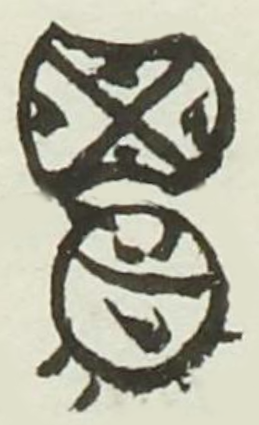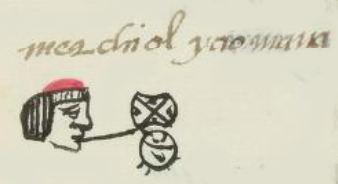Yaomana (MH876r)
This black-line drawing of the simplex glyph for the personal name Yaoman (“He Declares War”) is attested here as a man’s name. The glyph shows two war shields, with two different designs. The upper one has a shape where it appears the top and the bottom have a scoop out of the whole, curving inward, while the right and left edges curve outward. An X reaches from corner to corner, and there is a mark in each of the quadrants made by the X. The lower shield, connected by a line to the upper one, is round with some fringe at the bottom. A curving line cuts across the shield, leaving a larger portion at the bottom than at the top. Each of these regions have marks in them. These are typically U-shapes, but they are hastily drawn here. Both designs are very common Nahua shield designs.
Stephanie Wood
Having two shields, each one referring to a combatant perhaps of a different group, may imply that they would be pitted against one other.
Stephanie Wood
merchiol yaomana
Melchor Yaomana
Stephanie Wood
1560
Jeff Haskett-Wood
escudos, guerras, guerreros, comportamiento, nombres de hombres

yaomana, to declare war, https://nahuatl.wired-humanities.org/content/yaomana
Declara Guerra
Stephanie Wood
Matrícula de Huexotzinco, folio 876r, World Digital Library, https://www.loc.gov/resource/gdcwdl.wdl_15282/?sp=824&st=image.
This manuscript is hosted by the Library of Congress and the World Digital Library; used here with the Creative Commons, “Attribution-NonCommercial-ShareAlike 3.0 License” (CC-BY-NC-SAq 3.0).


